
James Barney Marsh was an American engineer and bridge designer. He patented a new design for arch bridges. Marsh gave Archie Alexander, the first African-American to graduate as an engineer from Iowa State University, his first job. Marsh worked in the bridge building business for over 50 years, and several of his bridges are listed in the National Register of Historic Places.

The Stewart Creek Bridge or Bridge L6007 is a stone arch bridge in the Smithville neighborhood of Duluth, Minnesota, United States. It was built around 1925 as part of the scenic Skyline Parkway overlooking the city. The Stewart Creek Bridge was listed on the National Register of Historic Places in 1989 under the name Bridge No. L-6007 for its state-level significance in the theme of engineering. It was nominated for being the most picturesque stone arch road bridge in design and setting in Minnesota.

There are eight properties listed on the National Register of Historic Places (NRHP) in Linn County, Kansas. Two of the sites are the location of historic events. The Marais des Cygnes Massacre Site is the location of the Marais des Cygnes massacre, an 1858 event during Bleeding Kansas in which pro-slavery advocates kidnapped 11 anti-slavery settlers, killing five of them. John Brown temporarily used the site as a fort, and the property was listed on the NRHP in 1971. The Battle of Mine Creek Site preserves the location of the Battle of Mine Creek, which was fought in 1864 as part of Price's Raid during the American Civil War. Confederate general Sterling Price's army was retreating after being defeated at the Battle of Westport and was attacked by pursuing Union troops. Price's Confederate lost heavily in men and supplies. The site was added to the NRHP in 1973.

The Pithole Stone Arch Bridge is a 37-foot (11 m) masonry, deck arch bridge that spans Pithole Creek between Cornplanter and President Townships, Venango County in the U.S. state of Pennsylvania. The bridge was listed on the National Register of Historic Places in 1988 and was documented by the Historic American Engineering Record (HAER) in 1997.
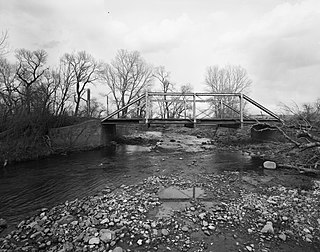
The ECS Bridge over Big Goose Creek was a bridge near Sheridan, Wyoming, that was built in 1914. It was a Pratt pony truss bridge built by the Canton Bridge Company of Canton, Ohio. The Canton Bridge Company built four steel bridges in Wyoming in 1914; when nominated to the National Register of Historic Places in 1982, the ECS Bridge was the only one of these surviving in its original location. It was 50 feet (15 m) long and 15 feet (4.6 m) wide.

The Christine Falls Bridge is a reinforced concrete arch bridge in Mount Rainier National Park, spanning Van Trump Creek at Christine Falls. The bridge was built in 1927–1928 by contractor J. D. Tobin of Portland, Oregon, who built the Narada Falls Bridge at the same time. The arch has a three-centered profile and spans 56 feet (17 m). The bridge is 30 feet (9.1 m) wide. It was faced with rubble stonework and is an example of National Park Service Rustic design.
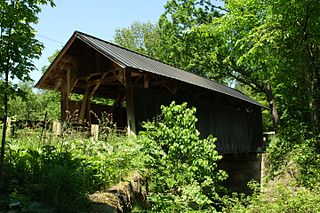
The Seguin Covered Bridge, also called the Upper Covered Bridge and the Sequin Covered Bridge, is a wooden covered bridge that crosses Lewis Creek in Charlotte, Vermont on Roscoe Road. It was built about 1850, and is a distinctive variant of a Burr arch design. It was listed on the National Register of Historic Places in 1974.
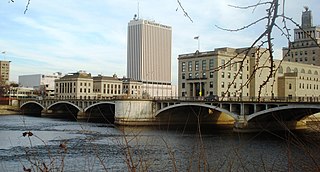
The First Avenue Bridge is a historic structure located in downtown Cedar Rapids, Iowa, United States. It carries U.S. Route 151 for 697 feet (212 m) over the Cedar River. The original six-span concrete arch structure was completed in 1920 for $420,000. It was designed by Marsh Engineering Company and built by Koss Construction Co., both of Des Moines. Consulting engineer Ned L. Ashton of Iowa City designed the 1960s remodel. He had all of the concrete work above the original arches torn out and the bridge rebuilt as an open-spandrel structure. The rebuild also included a wider deck to accommodate increased traffic and aluminum railings. While the bridge's original structural integrity has been compromised, this is the first notable concrete spandrel arch reconstruction in Iowa and possibly in the country. The bridge was listed on the National Register of Historic Places in 1998.
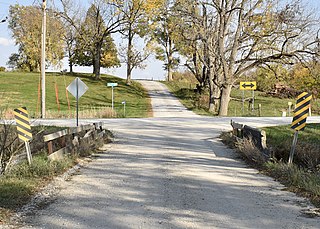
The Calamus Creek Bridge near Maxwell, Iowa is a concrete Luten arch bridge constructed in 1905. It was built by N. M. Stark and Company for a cost of $900. It has a 25-foot (7.6 m) single span and a total length of 45 feet (14 m).

The Indian Creek Bridge is a wrought iron bridge, built about 1880 to the east of Cedar Rapids, Iowa. The bridge crosses a tributary of the Cedar River in Linn County. It was designed and built by the Wrought Iron Bridge Company (WIBCO) of Canton, Ohio as an eight-panel pin-connected through truss in an unusual double-intersection Pratt design.

The EDL Peloux Bridge near Buffalo, Wyoming, is a Pratt pony truss bridge that was built in 1912 by the Canton Bridge Company. The bridge carries Johnson County Road CN16-40 across Clear Creek. The single-span bridge is 81.5 feet (24.8 m) long and has a wooden roadway supported by steel pins and piles. The bridge was placed on the National Register of Historic Places in 1985 as part of a Multiple Property Submission devoted to historic bridges in Wyoming The bridge was relocated to Buffalo City Park in 1986.

The EJE Bridge over Shell Creek is a Warren pony truss bridge located near Shell, Wyoming, which carries Big Horn County Road CN9-57 across Shell Creek. The bridge was built in 1920 by the Midland Bridge Company, the only firm to bid for the bridge contract. At 60 feet (18 m) long, it is the longest known example of a Warren pony truss bridge in Wyoming.
The Miller Ree Creek Bridge is a historic bridge in Miller, South Dakota. It is a single-span Marsh rainbow arch concrete bridge, carrying 2nd Street over Ree Creek just west of the town. The bridge consists of two concrete arches, from which the floor supports are suspended. The bridge is 42 feet (13 m) long and 22 feet (6.7 m) wide, rising about 10 feet (3.0 m) above the stream bed. Built in 1914, this bridge is one of only three bridges of the type to survive in the state, and is the best-preserved of the three.

The Marble Bridge, formally known as the Fletcher D. Proctor Memorial Bridge, carries Main Street across Otter Creek in the center of Proctor, Vermont. Built in 1915, and widened in 1935-36, it is a well-preserved example of early concrete bridge construction, and is decoratively faced in local marble. The bridge was listed on the National Register of Historic Places in 1991.

The Landers Creek Bridge, also known as the Goodrich Bridge and located at the southern edge of Goodrich in Linn County, Kansas, is a stone arch bridge which was built in 1917. It was listed on the National Register of Historic Places in 1985.

The IANR Railroad Underpass is a historic structure located in Cedar Rapids, Iowa, United States. It carried railroad tracks for 24 feet (7.3 m) over Ely Road. The railroad probably built this stone arch bridge, which was completed in 1887. This kind of structure became more popular in the late 19th century as a railroad bridge because it was more durable than metal truss bridges, and they "projected a refined and sophisticated image." It features a semi-circular arch, a beltcourse, coursed-ashlar masonry, stepped wing walls that are flared, a parapet with projecting coping, and an elongated keystone with the date "1887" carved on it. The bridge was listed on the National Register of Historic Places in 1998. It now carries the Cedar River Recreation Trail over the street.
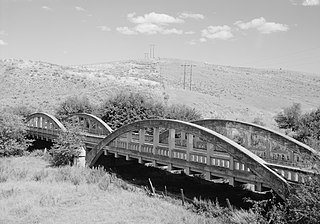
The Indian Timothy Memorial Bridge is a tied-arch bridge which spans Alpowa Creek less than half a mile before that creek joins the Snake River, about 8 miles (13 km) west of Clarkston in Asotin County, Washington. It was built by the Washington State Department of Transportation in 1923 and was listed on the National Register of Historic Places in 1982.

The West Sixth Street Bridge is a historic stone arch bridge in downtown Austin, Texas. Built in 1887, the bridge is one of the state's oldest masonry arch bridges. It is located at the site of the first bridge in Austin, carrying Sixth Street across Shoal Creek to link the western and central parts of the old city. The bridge was added to the National Register of Historic Places in 2014.
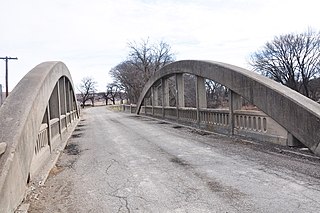
The Conroe Bridge, also known as Clark's Creek Bridge, is a Rainbow Arch bridge over Clark's Creek near Junction City, Kansas which was built in 1925. It was listed on the National Register of Historic Places in 1983.

The Cedar Creek Bridge near Elgin, Kansas, on FAS 96, was built in 1927. Also known as Elgin Cedar Creek Bridge, it was listed on the National Register of Historic Places in 1983.






















